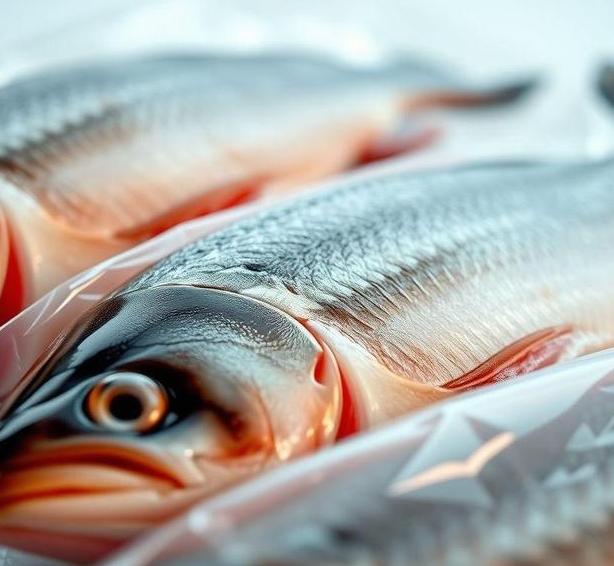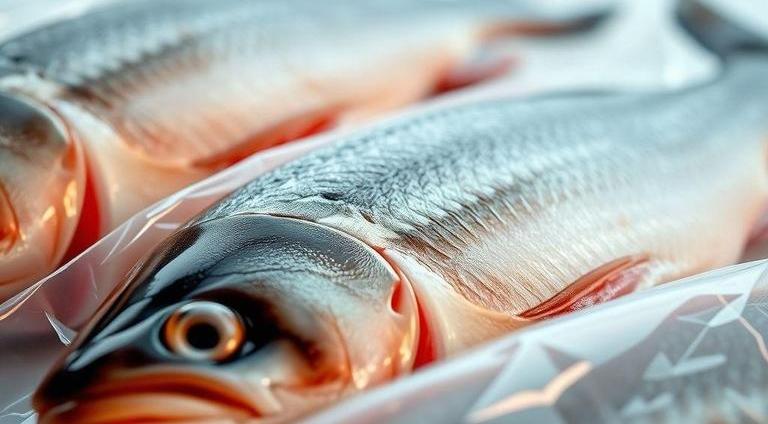Can Vacuum Sealed Fish Go Bad : What You MUST Know
Vacuum sealing is an incredibly effective method for preserving food, especially fish, which tends to spoil quickly due to its high moisture content and delicate nature. The process of vacuum sealing removes air from the packaging, slowing down the growth of bacteria and mold and extending the freshness of the fish. However, just because fish is vacuum sealed doesn’t mean it’s immune to spoiling. There are several factors that can influence how long vacuum sealed fish lasts, how to store it properly, and how to tell if it’s gone bad.
If you’re someone who frequently buys fish in bulk, enjoys stocking up for long trips, or just loves the convenience of ready-to-use seafood, understanding how vacuum sealing affects the shelf life of fish can be a game-changer.
Let’s dive deep into the intricacies of vacuum sealed fish, from the potential for spoilage to the best storage techniques and expert advice on how to keep your fish fresh for as long as possible.
Can Vacuum Sealed Fish Go Bad?
Absolutely, vacuum sealed fish can go bad. While vacuum sealing greatly extends the freshness of fish, it doesn’t make it impervious to spoilage. The key to understanding this is knowing how vacuum sealing works and the conditions it maintains.
- Air Removal: By sealing the fish in a vacuum, you remove the oxygen that bacteria, mold, and other microorganisms need to thrive. This creates an environment where spoilage is slowed down significantly.
- Temperature Sensitivity: Even though air is removed, vacuum-sealed fish is still highly susceptible to temperature fluctuations. If it’s not kept at the right temperature, it can go bad much quicker than expected.
- Time Frame: While vacuum sealing slows the spoiling process, the fish will eventually degrade, just like any other food product. Factors like the type of fish, how fresh it was when sealed, and how it was handled before sealing play major roles in its eventual shelf life.
So, while vacuum sealing does buy you extra time, it’s still important to keep an eye on the fish and store it properly. Here’s how you can ensure it stays good for as long as possible.
Shelf Life For Vacuum Sealed Fish

The shelf life of vacuum sealed fish depends on several key factors: the type of fish, the method of sealing, and how it’s stored. Let’s break it down based on different types of fish and storage methods.
Refrigerated Vacuum Sealed Fish
- Lean Fish (e.g., cod, haddock): Generally, lean fish will last between 1 to 2 weeks in the fridge when vacuum sealed.
- Fatty Fish (e.g., salmon, mackerel, trout): Fatty fish, because of their higher oil content, have a shelf life of about 5-7 days in the refrigerator.
- Crustaceans (e.g., shrimp, lobster): These can last about 2 to 3 weeks if vacuum sealed and stored properly in the fridge.
Frozen Vacuum Sealed Fish
- Lean Fish: When frozen, lean fish can last up to 12 months.
- Fatty Fish: Frozen fatty fish typically lasts about 6 to 9 months. The fats in the fish can turn rancid over time, even when vacuum sealed.
- Crustaceans: When frozen, shrimp or lobster can stay fresh for 12 months.
The key takeaway here is that the cold temperatures are your best friend when it comes to preserving vacuum sealed fish for long-term use.
Common Signs Of Spoilage
Even when vacuum sealed, fish is still vulnerable to certain conditions that can cause it to go bad. Here are some of the most common signs to watch out for when inspecting your vacuum-sealed fish:
- Off Smell: Fish, even vacuum sealed, should never smell overly “fishy” or sour. If you notice a pungent, rancid odor or a strong ammonia-like smell, it’s a clear sign that the fish has gone bad. Trust your nose-fresh fish should have a mild, oceanic scent.
- Slimy or Discolored Flesh: Fish flesh should be firm, moist, and translucent. If the flesh feels slimy, discolored, or mushy, it’s a sign that spoilage is happening. Pay attention to the color-any dullness or yellowing can indicate oxidation or bacterial growth.
- Broken Seal: If you notice that the vacuum-sealed packaging is compromised, it could allow bacteria and air inside, which can cause spoilage. If the seal is broken or there are any holes in the packaging, discard the fish.
- Visible Ice Crystals: If the fish has been stored in the freezer, but there are a lot of ice crystals inside the bag, it could mean the fish has thawed and refrozen, compromising its quality and safety.
- Soft or Mushy Texture: Fresh fish should feel firm to the touch. If the texture has become soft or mushy, it’s likely an indication that it’s no longer safe to eat.
How To Store Vacuum Sealed Fish?

The way you store your vacuum-sealed fish is critical to ensuring it lasts as long as possible. Below are the best practices for storing vacuum-sealed fish, whether in the fridge or freezer:
In The Refrigerator
- Temperature: Always store vacuum-sealed fish at a temperature of 32°F (0°C). This keeps it from spoiling too quickly while still maintaining its quality.
- Storage Placement: Keep vacuum-sealed fish in the coldest part of your fridge, typically at the back of the bottom shelf. Avoid placing it near the door, as the temperature fluctuates every time it’s opened.
- Expiration Dates: If the vacuum-sealed fish has an expiration or “use by” date on it, make sure to consume it by that date to ensure freshness. However, if you open the package early, consume the fish within a few days.
In The Freezer
- Temperature Control: Make sure your freezer is at 0°F (-18°C) or lower. Fish that is stored at higher temperatures can degrade in quality, and the seal may not remain intact for as long.
- Proper Packing: If you’re not freezing fish right away, make sure the vacuum-sealed bags are stored in a way that avoids puncturing or crushing. Double-bagging can help, particularly for fatty fish that can get freezer burn more easily.
- Labeling: Always label the vacuum-sealed bags with the date of sealing and the type of fish. This will help you keep track of how long it’s been stored and avoid keeping it too long.
Thawing
- In the Fridge: The best method to thaw vacuum-sealed fish is in the refrigerator. It keeps the fish at a safe temperature and preserves its texture and flavor. Ideally, thaw for 24 hours.
- Cold Water Method: If you need the fish sooner, you can submerge the vacuum-sealed package in cold water. This method can thaw fish in about an hour, depending on size.
Expert Tips
- Use the “First In, First Out” (FIFO) Method: If you have multiple vacuum-sealed fish packs in your fridge or freezer, always use the oldest ones first. This helps reduce waste and ensures you’re using the fish before it starts to spoil.
- Avoid Refreezing: If your vacuum-sealed fish has thawed, do not refreeze it. This will significantly degrade its quality, and in some cases, could lead to foodborne illness. Once thawed, cook it promptly.
- Dry Ice for Long-Term Freezing: If you’re storing vacuum-sealed fish for a long period (more than 6 months), using dry ice during storage can maintain lower temperatures, preventing freezer burn and extending the shelf life.
- Double Seal for Extra Protection: If you plan on storing fish for extended periods, consider double-sealing the fish with an extra layer of vacuum-seal bags. This will protect against any punctures or minor issues with the first layer of sealing.
FAQs
How Long Can Vacuum Sealed Fish Last?
Vacuum-sealed fish can last anywhere from 1 to 2 weeks in the refrigerator. However, if frozen, it can last from 6 to 12 months, depending on the type of fish and storage conditions.
Can Vacuum Sealed Fish Spoil If Not Refrigerated?
Yes, vacuum sealed fish can spoil if not kept refrigerated. It is important to store vacuum sealed fish at temperatures below 40°F (4°C) to maintain its freshness.
How Can You Tell If Vacuum Sealed Fish Has Gone Bad?
Signs of spoiled vacuum sealed fish include a sour or off odor, a slimy or discolored texture, and a change in color. If the vacuum seal is broken, the fish should be discarded immediately.
Does Vacuum Sealing Preserve Fish Indefinitely?
No, vacuum sealing does not preserve fish indefinitely. While it can extend the shelf life, fish will still deteriorate over time, particularly due to the natural breakdown of proteins and fats.
What Happens If Vacuum Sealed Fish Is Stored At Room Temperature?
Storing vacuum sealed fish at room temperature accelerates the growth of harmful bacteria, leading to food spoilage. Fish should never be left out at room temperature for extended periods.
Can You Freeze Vacuum Sealed Fish?
Yes, freezing vacuum sealed fish is a great way to preserve its freshness for an extended period. It should be kept at 0°F (-18°C) to prevent freezer burn and maintain quality.
Is It Safe To Eat Vacuum Sealed Fish Past Its Expiration Date?
It is not recommended to eat vacuum sealed fish past its expiration date, as it may pose health risks due to bacterial growth or spoilage. Always check for signs of spoilage before consuming.
How Does Vacuum Sealing Affect The Texture And Taste Of Fish?
Vacuum sealing preserves the texture and taste of fish by preventing exposure to air, which can cause oxidation and freezer burn. However, freezing may slightly alter the texture of some types of fish.
Can Vacuum Sealed Fish Be Stored Without Refrigeration?
Vacuum sealed fish should not be stored without refrigeration unless it is freeze-dried or processed for long-term storage. Without proper cold storage, it will spoil quickly.
What Should I Do If The Vacuum Seal On My Fish Is Broken?
If the vacuum seal is broken, the fish should be consumed immediately or discarded if it shows any signs of spoilage. Once opened, the fish is exposed to air and can deteriorate quickly.
